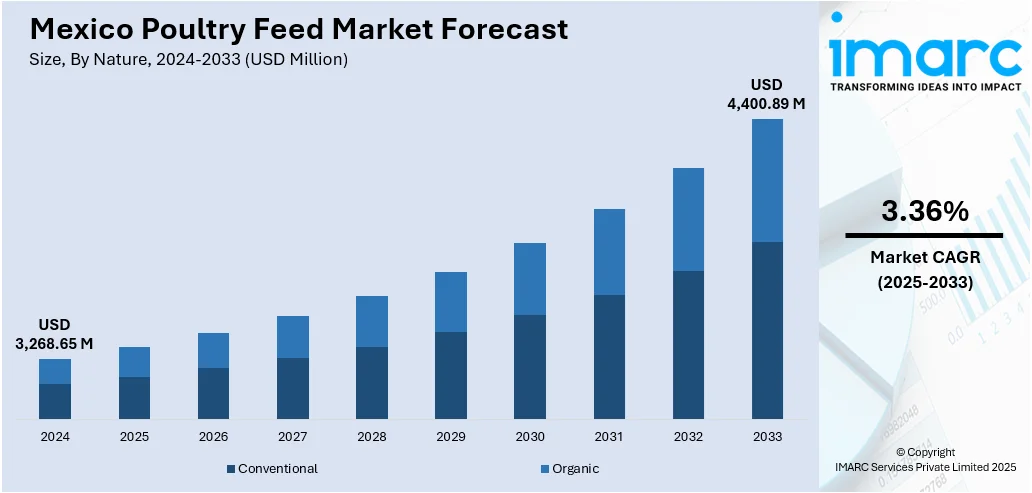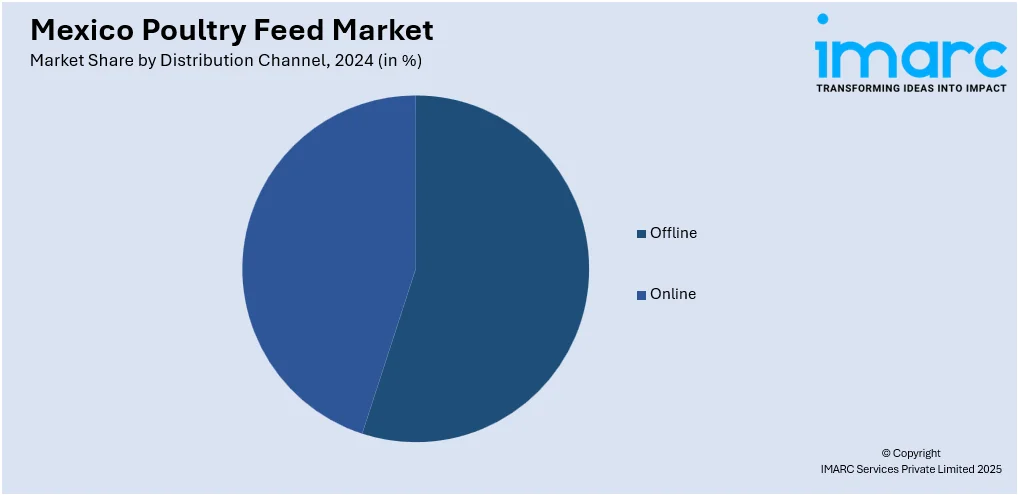
Mexico Poultry Feed Market Size, Share, Trends and Forecast by Nature, Form, Additives, Animal Type, Distribution Channel, and Region, 2025-2033
Mexico Poultry Feed Market Overview:
The Mexico poultry feed market size reached USD 3,268.65 Million in 2024. Looking forward, IMARC Group expects the market to reach USD 4,400.89 Million by 2033, exhibiting a growth rate (CAGR) of 3.36% during 2025-2033. The rising poultry meat and egg consumption, the expansion of intensive commercial farming under supportive government policies, ongoing technological improvements, the advent of nutrient-dense, additive-enhanced formulations, and a shift towards sustainable, alternative feed ingredients are among the key factors strengthening the market growth.
|
Report Attribute
|
Key Statistics
|
|---|---|
|
Base Year
|
2024
|
|
Forecast Years
|
2025-2033
|
|
Historical Years
|
2019-2024
|
| Market Size in 2024 | USD 3,268.65 Million |
| Market Forecast in 2033 | USD 4,400.89 Million |
| Market Growth Rate 2025-2033 | 3.36% |
Mexico Poultry Feed Market Trends:
Proliferation of Advanced Feed Additives & Precision Nutrition
Mexico’s poultry-feed formulators are increasingly investing in high-value additives like amino acids, enzymes, probiotics, and phytogenic to improve feed-conversion efficiency, enhance bird health, and maintain antibiotic-free standards. Amino acids, the largest revenue-generating segment in poultry feed additives, reflect producers' emphasis on precise amino acid balancing to reduce protein inclusion rates while still meeting growth targets. Rising production costs, with feed accounting for over 70% of total broiler production expenses, have driven integrators to maximize efficiency through targeted additives. Stricter residue and antibiotic regulations, both domestically and in key export markets, are fueling the adoption of natural binders, organic acids, and enzyme blends that support gut health without the use of antimicrobials. Additionally, digital feed-management platforms allow real-time monitoring of additive performance, enabling feed mills to adjust inclusion rates dynamically, thereby creating a positive outlook for market expansion.

To get more information on this market, Request Sample
Adoption of Sustainable & Alternative Protein Sources
In response to ESG mandates and growing pressure to reduce reliance on imported soybean meal and fishmeal, Mexico’s poultry-feed industry is quickly integrating alternative proteins, particularly insect meals, and plant-derived phytogenic into layer and broiler rations. These alternative ingredients are further supported by a surge in domestic demand, with poultry consumption in Mexico projected to increase by 3%, reaching 5.1 million MT by 2025, driven by both retail and hotel-restaurant-institutional (HRI) channels. By combining insect- and plant-derived proteins with traditional grains, feed millers can achieve superior feed-conversion ratios and lower lifecycle carbon footprints, offering compelling benefits for major integrators targeting both domestic and export markets. This shift toward sustainable, locally sourced ingredients aligns with the broader trend of improving efficiency and reducing environmental impact, ensuring the sector’s competitiveness and compliance with evolving sustainability expectations.
Mexico Poultry Feed Market Segmentation:
IMARC Group provides an analysis of the key trends in each segment of the market, along with forecasts at the region/country level for 2025-2033. Our report has categorized the market based on nature, form, additives, animal type, and distribution channel.
Nature Insights:
- Conventional
- Organic
The report has provided a detailed breakup and analysis of the market based on the nature. This includes conventional and organic.
Form Insights:
- Mashed
- Pellets
- Crumbles
- Others
A detailed breakup and analysis of the market based on the form have also been provided in the report. This includes mashed, pellets, crumbles, and others.
Additives Insights:
- Antibiotics
- Vitamins
- Antioxidants
- Amino Acid
- Feed Enzymes
- Feed Acidifiers
- Others
The report has provided a detailed breakup and analysis of the market based on the additives. This includes antibiotics, vitamins, antioxidants, amino acid, feed enzymes, feed acidifiers, and others.
Animal Type Insights:
- Layers
- Broilers
- Turkey
- Others
A detailed breakup and analysis of the market based on the animal type have also been provided in the report. This includes layers, broilers, turkey, and others.
Distribution Channel Insights:

- Offline
- Online
The report has provided a detailed breakup and analysis of the market based on the distribution channel. This includes offline and online.
Regional Insights:
- Northern Mexico
- Central Mexico
- Southern Mexico
- Others
The report has also provided a comprehensive analysis of all the major regional markets, which include Northern Mexico, Central Mexico, Southern Mexico, and others.
Competitive Landscape:
The market research report has also provided a comprehensive analysis of the competitive landscape. Competitive analysis such as market structure, key player positioning, top winning strategies, competitive dashboard, and company evaluation quadrant has been covered in the report. Also, detailed profiles of all major companies have been provided.
Mexico Poultry Feed Market News:
- February 2025: Trouw Nutrition opened a USD 48.8 million animal feed plant in Querétaro, Mexico, with a focus on poultry. The facility can produce 100,000 tons annually across specialized lines for poultry, ruminants, and pellets.
- February 2024: Pilgrim’s Mexico, a poultry producer, revealed plans to open a new hatchery and feed mill in Merida, Yucatan. With 60% of breeder farm relocations completed, the firm aims to boost overall efficiency.
Mexico Poultry Feed Market Report Coverage:
| Report Features | Details |
|---|---|
| Base Year of the Analysis | 2024 |
| Historical Period | 2019-2024 |
| Forecast Period | 2025-2033 |
| Units | Million USD |
| Scope of the Report |
Exploration of Historical Trends and Market Outlook, Industry Catalysts and Challenges, Segment-Wise Historical and Future Market Assessment:
|
| Natures Covered | Conventional, Organic |
| Forms Covered | Mashed, Pellets, Crumbles, Others |
| Additives Covered | Antibiotics, Vitamins, Antioxidants, Amino Acid, Feed Enzymes, Feed Acidifiers, Others |
| Animal Types Covered | Layers, Broilers, Turkey, Others |
| Distribution Channels Covered | Offline, Online |
| Regions Covered | Northern Mexico, Central Mexico, Southern Mexico, Others |
| Customization Scope | 10% Free Customization |
| Post-Sale Analyst Support | 10-12 Weeks |
| Delivery Format | PDF and Excel through Email (We can also provide the editable version of the report in PPT/Word format on special request) |
Key Questions Answered in This Report:
- How has the Mexico poultry feed market performed so far and how will it perform in the coming years?
- What is the breakup of the Mexico poultry feed market on the basis of nature?
- What is the breakup of the Mexico poultry feed market on the basis of form?
- What is the breakup of the Mexico poultry feed market on the basis of additives?
- What is the breakup of the Mexico poultry feed market on the basis of animal type?
- What is the breakup of the Mexico poultry feed market on the basis of distribution channel?
- What is the breakup of the Mexico poultry feed market on the basis of region?
- What are the various stages in the value chain of the Mexico poultry feed market?
- What are the key driving factors and challenges in the Mexico poultry feed market?
- What is the structure of the Mexico poultry feed market and who are the key players?
- What is the degree of competition in the Mexico poultry feed market?
Key Benefits for Stakeholders:
- IMARC’s industry report offers a comprehensive quantitative analysis of various market segments, historical and current market trends, market forecasts, and dynamics of the Mexico poultry feed market from 2019-2033.
- The research report provides the latest information on the market drivers, challenges, and opportunities in the Mexico poultry feed market.
- Porter's five forces analysis assist stakeholders in assessing the impact of new entrants, competitive rivalry, supplier power, buyer power, and the threat of substitution. It helps stakeholders to analyze the level of competition within the Mexico poultry feed industry and its attractiveness.
- Competitive landscape allows stakeholders to understand their competitive environment and provides an insight into the current positions of key players in the market.
Need more help?
- Speak to our experienced analysts for insights on the current market scenarios.
- Include additional segments and countries to customize the report as per your requirement.
- Gain an unparalleled competitive advantage in your domain by understanding how to utilize the report and positively impacting your operations and revenue.
- For further assistance, please connect with our analysts.
 Request Customization
Request Customization
 Speak to an Analyst
Speak to an Analyst
 Request Brochure
Request Brochure
 Inquire Before Buying
Inquire Before Buying




.webp)




.webp)












